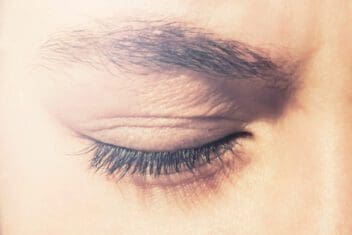Understanding Photophobia: Causes, Treatment, Management
Home / Eye Conditions & Eye Diseases /
Last Updated:
When the light is bright, if you experience discomfort, you may be experiencing photophobia. This is a common issue that can occur as a symptom of a number of conditions and other problems.
Table of Contents
In addition to light sensitivity, there are other symptoms that may occur along with photophobia, such as pain.
After getting a diagnosis, the doctor will discuss different treatment options with you. This often includes a combination of treating the underlying condition and alleviating your photophobia symptoms.
Along with medical treatment, there are things doctors might recommend you do at home. These management techniques may help to further alleviate your symptoms.
What Is Photophobia?
The literal translation of photophobia from Greek is “fear of light.” If you have photophobia, it means your eyes are abnormally sensitive or intolerant to light.
Photosensitivity leads to eye or head discomfort, causing you to take evasive action to avoid the light. Severe cases of photophobia may lead to extreme eye pain, even in low light.
You deserve clear vision. We can help.
With 135+ locations and over 2.5 million procedures performed, our board-certified eye surgeons deliver results you can trust.
Your journey to better vision starts here.
Photophobia is not a disease itself but a symptom of a condition. Many medical conditions may cause photosensitivity, such as:
- Eye conditions such as blepharospasm and uveitis
- Migraines
- Genetics
- Nervous system conditions like Sjögren’s syndrome
- Mild traumatic brain injury (MTBI)
Photophobia is a fairly common problem, presenting itself in people with migraines. In fact, 80% of people who experience migraines complain of their eyes being sensitive to light.
The problem is so common in people with migraines that it’s one of the symptoms doctors look out for to diagnose migraines. If you have chronic migraines, you will be more sensitive to light.
The presence of photophobia means you are 98% likely to catch a headache. For patients with blepharospasm, a survey found 80% of them reported that stress, bright lights, and watching TV worsens their condition.
Ophthalmologists have long known that anterior segment diseases, such as dry eye syndrome and cataracts, cause photophobia.
In addition, there is a strong connection between photophobia and posterior segment eye disease (PSED) like glaucoma, diabetic retinopathy, and age-related macular degeneration (AMD). Photosensitivity frequently appears as an early symptom.
Similarly, 50% of patients suffering from post-trauma vision syndrome (PTVS) reported having photophobia. PTVS is a condition combining vision and space perception disorders happening after something affects your neurological setup.
People with depression, seasonal affective disorder, bipolar and agoraphobia are more sensitive to light.
Causes of Photophobia
The causes of photophobia range from minor to severe.

- Migraine headaches: Migraines often come with light sensitivity. During a migraine attack, approximately 80 percent of people experience photophobia. Several factors are believed to contribute to migraines, including certain foods, environmental changes, stress, and hormonal changes. In addition to light sensitivity, people may also experience nausea, vomiting, and head pain.
- Blepharospasm: This is characterized by the muscles that control the eyelids contracting abnormally. One survey determined that approximately four out of five people with this condition said that watching television, reading, stress, driving, and bright lights made their blepharospasm worse. Exactly what causes this issue remains unknown.
- Encephalitis: This condition is characterized by brain inflammation. Many factors can cause encephalitis, but viral infection is the most common cause. Some people only experience headache, fever, and mild flu-like symptoms. The condition can also become very serious and cause seizures, movement issues, problems with the senses, and confusion.
- Subarachnoid hemorrhage: This condition is characterized by bleeding, which results in blood accumulating between the tissues that surround the brain. It has the potential to lead to a stroke, brain damage, and death.
- Meningitis: A virus or bacteria can cause meningitis. There is also a form of this infection that results from fungi. This infection causes the membranes that form a protective covering over the spinal cord and brain to become inflamed. This infection can cause a headache, fever, vomiting, stiff neck, confusion, nausea, and light sensitivity.
- Scleritis: This condition is characterized by the eye becoming inflamed. Lupus and other diseases that impact the immune system are the most common causes. Women are affected more often than men. Symptoms can include photophobia, water eyes, eye pain, and blurry vision.
- Corneal abrasion: If anything gets into the eye, such as dirt or sand, it can result in a scratch on the cornea. If the abrasion becomes infected, the condition can progress to the formation of an ulcer on the cornea. A doctor should evaluate all suspected corneal abrasions.
- Conjunctivitis: This condition is also referred to as pink eye. It is characterized by the tissue that covers the white of the eye becoming inflamed or infected. In most cases, a virus is responsible for the infection. However, allergies and bacteria can also cause it. In addition to light sensitivity, people may experience redness, eye pain, and itching.
- Dry eye syndrome: People experience dry eye syndrome when their tear quality is poor or when they do not produce sufficient amounts of tears. Several factors can contribute to eye dryness, such as environmental factors, certain medications, getting older, and some medical conditions. The dryness can make the eyes uncomfortable and gritty.
Symptoms of Photophobia

While photophobia is itself a symptom of an underlying condition, it does present its own symptoms. You can detect photophobia definitively by taking an eye exam. The primary symptoms of photophobia include:
- Light sensitivity leading to avoidance of the light
- Normal lighting appears too bright
- Forehead pain
- Watery or excessively dry eyes
- Can’t focus on the pictures or text in reading material
- Squinting of one or all eyes to avoid the light
- Brightly colored spots, even when you close your eyes
Other symptoms may include nausea and fatigue. Photophobia will typically affect both eyes, but some eye conditions may cause it to present in only one eye.
Treatment Options
A medical doctor should evaluate all cases of photophobia. They can help to determine what the underlying cause is. Treating the underlying cause may help to alleviate the light sensitivity.
- Rest and medications are used to treat migraine headaches.
- Antibiotics are prescribed if conjunctivitis is present.
- Mild encephalitis typically requires bed rest, anti-inflammatory medications, and fluids. In severe cases, breathing assistance and other supportive care may be necessary.
- If a subarachnoid hemorrhage is present, the doctor will perform surgery. They will relieve the pressure by removing excess blood that has accumulated.
- Scleritis is typically treated with eye drops that work to decrease inflammation.
- If mild dry eye syndrome is present, artificial tears are given.
- If there is a corneal abrasion, the doctor usually prescribes antibiotic eye drops.
- If viral meningitis is present, rest and fluids are typically recommended. Bacterial meningitis is a medical emergency. Hospitalization is usually necessary.
Once the underlying condition is controlled, you may start to notice a reduction in the level of light sensitivity you experience.
You deserve clear vision. We can help.
With 135+ locations and over 2.5 million procedures performed, our board-certified eye surgeons deliver results you can trust.
Your journey to better vision starts here.
At-Home Management
There are certain things a doctor may recommend you do at home to manage your condition. These management techniques can be used in addition to medical treatment.
- Close your eyes when lights become too bright.
- Darken the rooms in your home.
- Avoid sunlight when possible, and only go out into the sunlight when wearing sunglasses.
- Wear dark glasses whenever you are around light that is too bright for you.

If you experience photophobia over the long term, you typically learn about the level of light you can tolerate. Should the tolerable light level decrease with time, it is important to alert your doctor regarding this change. This could indicate a worsening of the underlying condition that is causing the light sensitivity.
Photophobia Prevention
There is no way to completely prevent photophobia or the conditions that can cause it. However, there are things you can do to reduce the risk. Good hygiene and frequent handwashing can help you to reduce your risk of infections.
If someone is sick, avoid contact with them until they are no longer contagious. For bacterial meningitis, there is a vaccine available that can help people to build immunity against this potentially deadly infection.
Do not touch your eyes. Don’t share eye products, such as eye drops, or any makeup with other people.
If your eyes are dry, do not rub them. Instead, talk to your doctor about the type of eye drop that may be beneficial for alleviating this problem.
If you get migraine headaches, make note of your triggers. If you can avoid them, you’ll decrease the frequency of episodes.
Any time you experience photophobia, it is important to get an accurate diagnosis. There are treatment and management options that can help you find some relief from your symptoms.
You deserve clear vision. We can help.
With 135+ locations and over 2.5 million procedures performed, our board-certified eye surgeons deliver results you can trust.
Your journey to better vision starts here.
References
- What Causes Photophobia? Healthline.
- Photophobia. MedlinePlus.
- Acute Bacterial Meningitis. Merck Manuals.
- Meningococcal Vaccination: What Everyone Should Know. Centers for Disease Control and Prevention.
- Shedding Light on Photophobia. Journal of Neuro-Ophthalmology.
- Photophobia: Looking for Causes and Solutions. American Academy of Ophthalmology.
- Photophobia. (May 1, 2019). National Institutes of Health.
- Photophobia in Neurologic Disorders. (September 20, 2017). National Center for Biotechnology Information.
- Photophobia: Looking for Causes and Solutions. (November 2005). American Academy of Ophthalmology
- Understanding photophobia in mTBI. (January 19, 2021). American Optometric Association.
- Shedding Light on Photophobia. (March 2012). National Center for Biotechnology Information.
This content is for informational purposes only. It may have been reviewed by a licensed physician, but is not intended to serve as a substitute for professional medical advice. Always consult your healthcare provider with any health concerns. For more, read our Privacy Policy and Editorial Policy.
